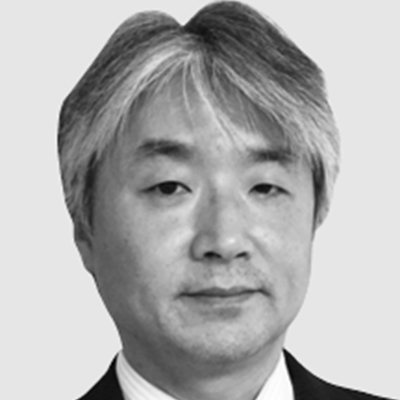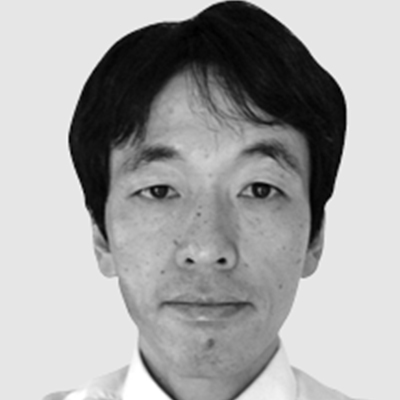Water Environment Solutions Based on Advanced Technology and Comprehensive Capabilities
Monitoring and control systems play a role in the daily operation and maintenance of water supply and sewerage facilities. Hitachi promotes the practice of working through the sense–think–act cycle helping to pursue digital innovations that will contribute to the sustainability of the water supply and sewerage industry. This article describes Hitachi's Internet of Things gateway that utilize operational technology data on the Internet of Things platform, optical fiber sensing as well as image analysis and voice recognition.

Hitachi Insight Group, Control System Platform Development, Public Control Systems Engineering Department, Hitachi, Ltd. Current work and research: Development of information and control systems for water/sewerage infrastructure. Certifications: P.E.Jp (Professional Engineer, Japan) of Information Engineering, Water Supply & Sewerage, and Engineering Management. Society memberships: The Institute of Electrical Engineers of Japan (IEEJ), The Society of Environmental Instrumentation, Control and Automation and The Society of Instrument and Control Engineers.

Hitachi Insight Group, Control System Platform Development, Public Control Systems Engineering Department, Hitachi, Ltd. Current work and research: Design and development of information and control systems for water/sewerage infrastructure.

Hitachi Insight Group, Control System Platform Development Department, Control System Platform Division, Hitachi, Ltd. Current work and research: Development of control system components.

Hitachi Insight Group, Control System Platform Development Department, Control System Platform Division, Hitachi, Ltd. Current work and research: Development of control system components.

Connectivity Systems Department, Center for Technology Innovation – Digital Technology, Research & Development Group, Hitachi Ltd. Current work and research: Optical fiber communication, optical power feeding, control and administration technologies. Society memberships: The Institute of Electronics, Information and Communication Engineers and IEEE.

Strategy & Planning Department, Social Infrastructure Systems Division, Water Business Unit, Hitachi, Ltd. Current work and research: Strategic planning of R&D for water supply and sewerage systems. Certifications: P.E.Jp (Professional Engineer, Japan) of Water Supply & Sewerage.
As the water supply and sewerage infrastructure built in Japan since the period of high economic growth is now coming due for replacement, work on these upgrades needs to be undertaken in a way that maintains a safe and secure water environment. Meanwhile, with the population of Japan declining, the work needs to be undertaken efficiently, with a limited workforce and severely constrained finances. Against this background, work on monitoring and control systems extends beyond daily facility operation and maintenance to include making good use of the operational technology (OT) data obtained via these systems to resolve the challenges facing the water supply and sewerage infrastructure, and to contribute to the sustainability of the water environment.
Furthermore, along with growing possibilities for sensing with the Internet of Things (IoT) in recent years, consideration is being given to using more detailed information and sources such as image data that have not been used as sensing data in the past.
This article presents examples of these possibilities in the form of a gateway that makes the OT data obtained by monitoring and control systems available for use on an IoT platform, an optical fiber sensing system for use inside sewage pipes (an application that has been difficult in the past), and the use of images and audio data as new sensing media.
In the field of monitoring and control, control devices with built-in computers called programmable logic controllers and process control stations are distributed near the equipment they are intended to control directly. Connecting these devices to a control local area network (LAN) makes it possible to collect data in a central monitoring and operation device for centralized monitoring and operation. This includes not only use as monitoring and control systems for individual facilities, such as water or sewage treatment plants and pumping stations, but also the use of telemetry or dedicated Internet Protocol (IP) lines to enable the interconnection and region-wide management of such facilities across the area served by a utility. In this way, the monitoring and control system themselves can form a network of things.
However, although these monitoring and control systems have been networked, the emphasis on realtime performance and reliability has meant that they have developed as closed systems specific to individual vendors. Being part of the social infrastructure, water supply and sewerage have also adopted closed networks because of their need for security. This means that, while they are a “network of things,” they are not part of the IoT.
To overcome the challenges described earlier, it is important to work through the sense–think–act cycle to plan for water supply and sewerage infrastructure, and make operational improvements. It is also desirable to have an open environment that can utilize the monitoring and control (OT) data. Ways of facilitating interoperation between monitoring and control systems are also needed by policies for regional coordination and catchment area management(7), (8).
While asset management is recommended to enable the development of plans that take lifecycle costs and investment leveling over time into consideration, achieving this requires not only OT data, but also data from information technology (IT) systems such as those for equipment records and customer service. This in turn requires cooperation between these OT and IT systems.
For these reasons, Hitachi is working on establishing IoT platforms that provide an open environment for cooperation between monitoring and control systems and between IT systems, while also taking account of security (see Figure 1).
Meanwhile, monitoring and control systems in the era of the IoT where all different types of things are connected to networks are opening up possibilities for sensing devices and equipment at a finer level of detail than in the past. Utilizing this information via IoT platforms not only makes operation and maintenance more efficient, but also has potential applications in the detection of aging or faulty devices and equipment.
Figure 1—Monitoring and Control System for the IoT Era Along with interoperating via an IoT platform, monitoring and control systems also need to make the data they contain available for use in making operational improvements and planning by cooperation with information systems.
Along with interoperating via an IoT platform, monitoring and control systems also need to make the data they contain available for use in making operational improvements and planning by cooperation with information systems.
Figure 2—Block Diagram of Hitachi's IoT Gateway Hitachi's IoT gateway consists of a three-tier structure including a gateway connector, a gateway manager, and a gateway adaptor. The gateway connector tier handles communication with monitoring and control systems, the top-level gateway adaptor tier handles communication with information systems, and the mid-level gateway manager tier provides a generalized interface for passing data between the upper and lower tiers.
Hitachi's IoT gateway consists of a three-tier structure including a gateway connector, a gateway manager, and a gateway adaptor. The gateway connector tier handles communication with monitoring and control systems, the top-level gateway adaptor tier handles communication with information systems, and the mid-level gateway manager tier provides a generalized interface for passing data between the upper and lower tiers.
If the utilization of OT data is to advance, the interconnection and exchange of data between monitoring and control systems and IoT platforms is essential. However, the control devices that make up a monitoring and control system, and the data structures and communication protocols they use, vary widely between applications, end uses, and system vendors. IoT platforms also have differences, such as the different applications, operating systems, and network environments used for different purposes, which means that linking control devices and IoT platforms together to exchange data is not easily accomplished.
Moreover, utilizing the data from monitoring and control systems for services on an IoT platform involves more than just resolving the communication issues. The data used in monitoring and control systems can be identified by various means, such as data nomenclatures, identification numbers (such as tag numbers), and device addresses, and oftentimes no information is included on how the data are used. What this means is that, even if the IoT platform can obtain OT data, large-scale data analysis and visualization is difficult, because the meaning of the data is unknown.
To resolve the above challenges, Hitachi has developed IoT gateway software to enable OT data from monitoring and control systems to be used on IoT platforms.
The main features of the Hitachi's IoT gateway software are as follows (see Figure 2).
Japan's Flood Protection Law was amended in 2015(2) with a requirement for measures to prevent basement/surface flooding in urban areas creating a greater need for water level measurement to deal with inundation as part of disaster management. Moreover, the aging of pipelines is becoming a challenge for maintenance. While this makes it important to visualize data on the conditions inside drain pipes, including water levels, corrosive gases, and water quality, the difficulty of securing a power supply inside a drain is an obstacle to remote real-time monitoring.
Optical fiber is being installed in sewage pipes for use in monitoring and control of sewerage operations and IT networking, and reached a total length of 2,250.1 km throughout Japan as of the end of FY2015(3). Because this fiber came through the Great East Japan Earthquake of 2011 with very little damage compared to other forms of communication, it has been receiving attention in recent years as a communication network that is resilient to earthquakes.
In response, Hitachi looked at the use of optical fiber in sewage pipes as a way to overcome the problems noted above. It developed a multi-sensing system (see Figure 3) that monitors measurements of water levels, corrosive gases, water quality, etc., and features an optical power feeding method that uses optical fiber not only for communicating, but also for delivering power(4).
The parent multi sensing (MS) box, which provides communication with the central monitoring system and is installed at the sewage treatment plant or pumping station, is connected via one strand of single-mode (SM) optical fiber to multiple MS boxes that are connected to sensors installed in the sewage pipes.
The parent MS box houses the light source and transmits a high-power laser beam through the optical fiber to the child MS boxes. The child MS boxes obtain the power supply for the sensors they house and for optical communication with the parent MS box by using photodetectors to convert this laser beam to electric power. Because they are limited by the capacity of this optical power feed, the child MS boxes use fine-tuned power control, such as intermittent operation of devices they house, to keep consumption to a minimum.
The example in Figure 3 shows a child MS box with four different sensors attached (water level switch, pressure-based water level sensor, conductivity gauge, and hydrogen sulfide sensor).
Waterproof connectors are used to facilitate installation and removal of the sensors. Because they are installed inside sewage pipes, the MS boxes themselves are also protected against water and corrosion (see Figure 4).
The multi-fiber sensing system provides a way to collect data from underground sewage pipes, something that has been difficult in the past, with potential for overcoming problems in pipe maintenance, deterioration and odor control, dealing with inflow and infiltration, and improving combined sewer overflows.
Figure 3—Block Diagram of Optical Fiber Multi-sensing System for Sewage Pipes The parent MS box at a sewage treatment plant or pumping station uses one strand of SM optical fiber to connect to multiple child MS box units installed in sewage pipes. The condition of sewage pipes can be monitored by connecting various sensors to the child MS boxes. In addition to its use for communication, the optical fiber is also used to deliver electric power to the sensors via an optical power feeding technology.
The parent MS box at a sewage treatment plant or pumping station uses one strand of SM optical fiber to connect to multiple child MS box units installed in sewage pipes. The condition of sewage pipes can be monitored by connecting various sensors to the child MS boxes. In addition to its use for communication, the optical fiber is also used to deliver electric power to the sensors via an optical power feeding technology.
It is now becoming possible to use sensing to utilize information in digital format that past monitoring and control systems were unable to handle.
From these initiatives, this article describes a wireless module for image analysis that enables the digitization and transmission of indicators from analog gauges that are intended to be read visually, and their utilization as time-series data. It also describes a hands-free inspection support system that uses on-the-spot voice input to collect data during site inspections that would have been written down by inspectors in the past.
Water supply and sewerage equipment still has a significant number of analog gauges that are not captured by monitoring and control systems. As these data are still needed for fine-tuned maintenance, the past practice has been to collect them during on-site inspections. As this involved paper-based management, it was rare to see that these data have been used digitally for equipment management and asset management.
In response, Hitachi developed a module with an autonomous, built-in power supply that uses a camera and image analysis to digitize readings from analog gauges and transmit the data wirelessly. Figure 5 shows a photograph of the module, and Figure 6 shows an example inspection automation system that uses wireless modules to connect to the network.
Removing or replacing analog gauges in the field during system installation is often difficult because they are directly attached to the pipes. Another challenge is that additional work is needed to lay power or data cables to outdoor and elevated locations. The wireless module for image analysis incorporates the following features to overcome these challenges.
In addition to using techniques such as spatial and frequency redundancy to achieve high reliability, the wireless network uses standard 2.4-GHz-band protocols to facilitate use around the world. This technique establishes a wireless mesh network automatically. While individual wireless modules have a range of only about 30 m, data can be transmitted over a wide area by relaying them from node to node (multi-hop communication).
By using low-power technologies and keeping the amount of transmitted data to a minimum, the wireless module is able to perform one inspection (meter reading) per day for three years with only its internal battery. Low power consumption was achieved by using fine-tuned control of power supply to reduce consumption in standby.
When using wireless communications with low power consumption, it is important to reduce the number of data sent. Image data are unsuitable because of the limits on transmission speed and the number of data that can be sent in each transmission. While image compression is a common way to reduce data size, it is difficult to achieve sufficient compression using existing techniques. Accordingly, the image data are analyzed by the wireless module and the resulting meter reading is sent instead.
Reading an analog dial meter involves analyzing the camera image to determine where the needle is pointing and then converting this to a numeric meter reading. This reduces the amount of data to send by a factor of approximately 30,000, from about 120 kbytes to 4 bytes, and reduces the number of transmissions from around 1,200 to just one.
The principle of having maintenance staff actually visit a site remains important even in the era of the IoT when all different types of things are networked. Such on-site inspections not only include checking meter readings and ticking off items on a checklist, but are also likely to include writing notes about what the inspector finds. One way to deal with this is to have the inspector input this information by voice and use voice recognition to make it available as digital data. In other words, to treat voice input as sensing data in the broad sense of the term.
Another motivation for using voice input is the desirability, for safety reasons, of being able to conduct hands-free on-site inspections, without the inspector having to carry around things like inspection sheets or pens.
However, because equipment often operates continuously, voice recognition must be able to work with noise levels of 100 dBA or more if it is to be used for inspection systems in the water supply and sewerage industry. In the case of sewerage infrastructure in particular, the system must function underground where network communications are unavailable. This means that the mobile device must be able to perform voice recognition on its own without relying on a network-connected server.
Figure 7 shows an overview of the hands-free inspection support system developed by Hitachi. The following features were developed in response to the challenges described above.
As a result, the system has high recognition accuracy, in the 89% to 97% range, and can be used in noisy environments such as near gas turbines or centrifugal dehydrators with noise levels above 100 dBA.
Figure 7—Block Diagram of Hands-free Inspection Support System To improve the efficiency of on-site inspections, maintain quality, and ensure safety, Hitachi developed an on-site inspection system that uses voice input and runs on a tablet. It also uses a personal acoustic model that supports use of a throat microphone and requires only a short learning time so that the system can be used for voice input in noisy environments and where the use of a wireless LAN is difficult.
To improve the efficiency of on-site inspections, maintain quality, and ensure safety, Hitachi developed an on-site inspection system that uses voice input and runs on a tablet. It also uses a personal acoustic model that supports use of a throat microphone and requires only a short learning time so that the system can be used for voice input in noisy environments and where the use of a wireless LAN is difficult.
This article has described an IoT gateway that provides the core technology for linking the OT data contained in monitoring and control systems in the water supply and sewerage industry to an IoT platform, and utilization of the devices for planning and operations. Sensing is a key part of the IoT and the article also described the use of optical fiber for monitoring the condition of sewage pipes as well as sensing techniques that include use of image and audio data.
Hitachi believes that these technologies can contribute to the sustainability of the water supply and sewerage infrastructure by facilitating the use of OT data acquired via monitoring and control systems in planning and operational improvement work.
The optical fiber multi-sensing system for sewage pipes described in this article was developed in collaboration with the Tokyo Metropolitan Sewerage Service Corporation and the Japan Sewer Optical Fiber Technological Association. Similarly, the hands-free inspection support system was developed in collaboration with the Tokyo Metropolitan Sewerage Service Corporation. The authors would like to take this opportunity to express their sincere thanks.